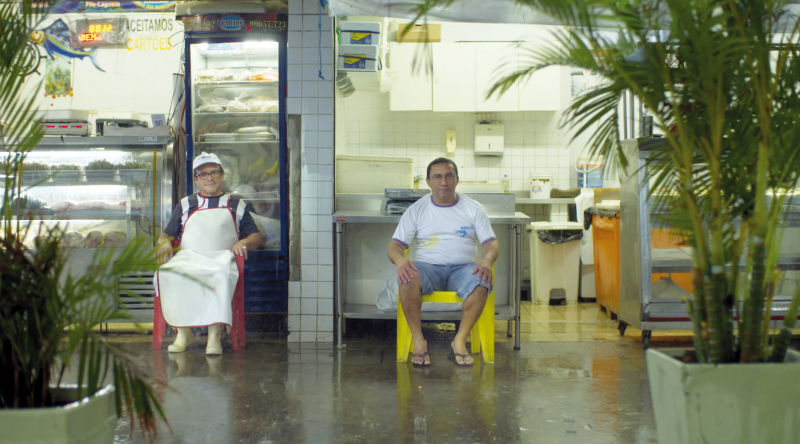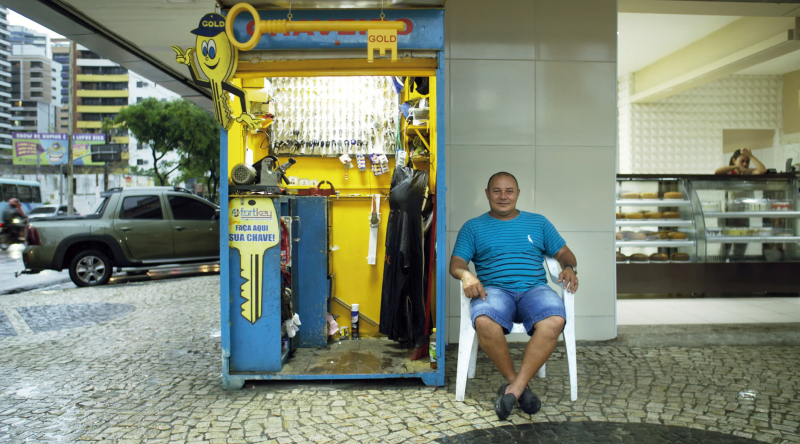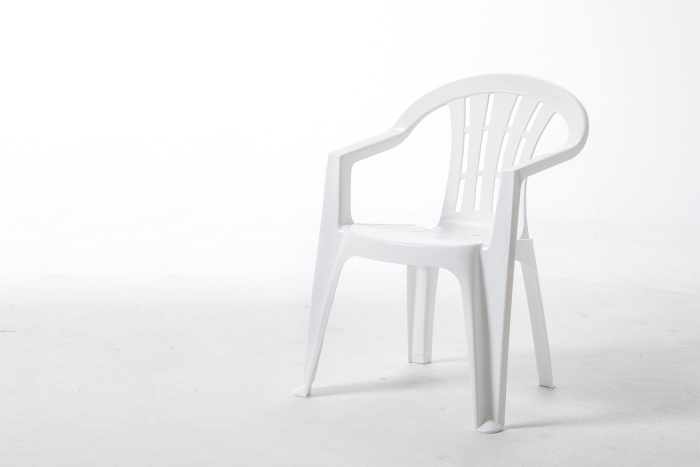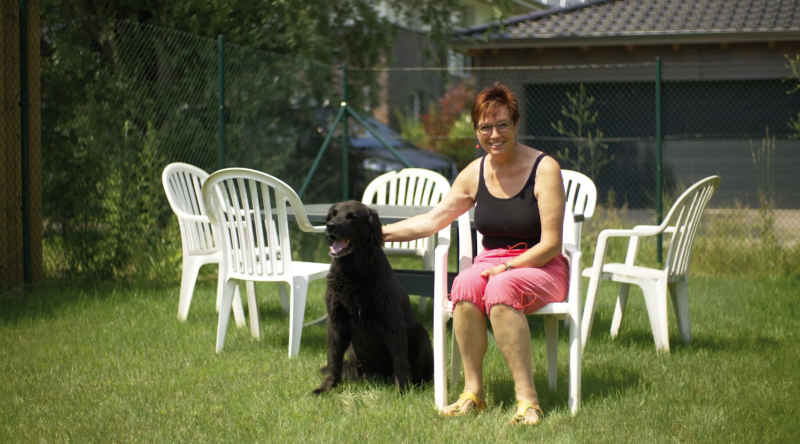Monobloc by Hauke Wendler
With furniture, as with so much in life, it is rarely the showy, high profile, works, or individuals, that teach us most, but those works, and those individuals, who in their anonymity and modesty accompany us in invisible silence.
Or rather the anonymous and quiet could teach us most, if we spent less time being distracted by, letting ourselves willingly be distracted by, the noise of the showy.
With the project Monobloc author and director Hauke Wendler, and a team of co-collaborators, offer us all an opportunity to focus on, and learn from, an object we’ve all seen and used, but only rarely, if ever, openly engaged with…….
According to Hauke Wendler the origins of the Monobloc project can be traced back to a photo he saw in a newspaper in February 2013; a photo from Yemen of a man walking through a forest of poorly ordered monobloc chairs in an otherwise deserted desert landscape; a photo which Wendler describes as “a beautiful photo full of questions and secrets and at the same time an incredible accumulation of plastic waste”.1 And a photo that engendered a fascination, one could almost imply obsession, that led to a film, a podcast and now a book.
And a “photo full of questions and secrets” that, in many regards, also stands as a metaphor for the many questions and secrets of the monobloc chair. Secrets and questions Monobloc allows one to frame and uncover and explore and ponder and re-frame on a journey through both the geography and the (hi)story of the monobloc.
For all that the monobloc chair is today popularly associated with cheap, insubstantial objects2, an “accumulation of plastic waste” in the making, the (hi)story of the monobloc essentially begins, as Hauke Wendler argues, with Verner Panton’s late 1950s eponymous reinforced fibreglass cantilever chair for Vitra, one of the first commercial moulded plastic chairs, before in the mid-1960s with Helmut Bätzner’s BA 1171 for Wilhelm Bofinger and Vico Magistretti’s Selene for Artemide, both formed from fibreglass reinforced polyester, both stackable, both formally reduced, both crafted from a minimum of material, both employing folds and curves to maximise stability, one very clearly joins the path to that which we today call the monobloc.
Or more accurately a path, for as Monobloc helps elucidate, there are many paths to the monobloc.
A second of which begins in 1948 in Nurieux in the French Jura, where and when a young entrepreneur named Henry Massonnet took over his father’s comb manufacturing business and transformed it into Société de Transformation des Matières Plastiques, a.k.a. STAMP, a company specialising in injection moulding of plastics, a company that, as with so many similar concerns at the period, profited greatly from a surge in the development of new synthetic plastics in the immediate post-War years, for all the arrival in the mid-1950s of polypropylene; and a company that operated successfully, if unspectacularly, for many years until in 1968 Massonnet designed a hyperbolic, drum-esque stool, known as Tam Tam: a stool Massonnet claims he sketched in five minutes, so logical was the form, a stool which was initially conceived for fishermen, for whom STAMP also produced cool boxes, and a stool which became an, unexpected, popular success in late 1960s France, selling some 12 million times at an initial retail price of 15 Francs.3
A success Massonnet sought to follow up with a polypropylene armchair, the so-called Fauteuil 300, a work widely acknowledged today as the first contemporary polypropylene monobloc chair.

Two gents in a market in Fortaleza, Brazil. On monoblocs. Sadly there are no names associated wit the sitters in the photos in Monobloc, they are as anonymous as the chairs on which they sit. (Photo © Boris Mahlau / PIER 53, courtesy Hatje Cantz)
As an object the Fauteuil 300 not only follows on structurally from the above quoted works by Bätzner and Magistretti in terms of its structural folds and curves, if greatly simplifying, improving, the stacking mechanism, but is an object which, as Jens Thiel argues, follows on formally (and structurally) from 1920s French moulded metal chairs; Thiel refers for all to Joseph Mathieu’s ca 1920 Multipl’s, a work produced in Lyon, and thus interestingly, or perhaps not, only an hour’s drive from Nurieux.
And a Fauteuil 300 that was launched, as part of a small family of plastic furniture objects primarily intended for the gardens of France, in 1972…….
…….¿1972?
Yes. And thus just at that moment when the combination of the oil crises of the early 1970s with their exponential increases in the cost of oil and thus of plastics, and the increasing awareness of the ecological impact human society and industry was having on our planet as exemplified by publications such as, and amongst others, the club of Rome’s Limits of Growth or Victor Papanek’s Design for the Real World, suddenly transformed plastics from the bringers of a bright democratic future they had offered in the immediate post-War decades into an irresponsible folly.
Thus Massonnet failed to repeat the popular success of Tam Tam with the Fauteuil 300.4
And the failure of the Fauteuil 300 could very well have seen the cheap, insubstantial monobloc chair end its days in a jurassien cul-de-sac.
Could.
However, the doubts about plastic that arose in the 1970s quickly evaporated as the European economic crises of the 1970s gave way to the European economic optimisms of the 1980s, and plastics once again became the guaranteed bringers of a bright democratic future.
And allowed a third path to the monobloc to open, in Merone on the banks of Lago di Pusiano in northern Italy.
And that, not inappropriately, in a garden.

A timber dealer in Katende, Uganda. On a monobloc. (Photo © Boris Mahlau / PIER 53, courtesy Hatje Cantz)
Specifically in the gardens of family Proserpio, owners of a plastic injection moulding factory.
One evening in the 1980s the Proserpio brothers were having dinner with a Dutch wholesaler with whom they had long been in business, a Dutch wholesaler who, as was his habit, after dinner popped next door to say hello to the Proserpios’ parents. And returned that evening from the parents’ house with a French monobloc chair, an object which, as good fortune would have it, had only recently been acquired for the parents’ garden. Could, the Dutch wholesaler asked, the Proserpios make such a chair, for if they could, he was certain he could sell 10,000.
And so the Proserpios developed a mould for a single piece plastic chair based on the single piece French plastic chair; taking extreme care as they did to incorporate enough variation so as not to create an exact copy of the French model. One can patent a form, and a machine to realise forms, but not a production process.5
Who the manufacturer, and designer, of that French model were/was is sadly not noted in Monobloc (Book); but one has to assume it was one of Massonnet’s through STAMP.
What is noted in Monobloc (Book) is that since that first 1980s commission for 10,000 monoblocs6 family Proserpio have produced, by their own calculations, some 240 million monoblocs; and as Monobloc opines that Dutch-Italian adaptation of a French object essentially marks the beginning of the monobloc’s rise to a cheap, insubstantial, global sitting device.
Marks the beginning of the framing and uncovering and exploring and pondering and re-framing of the many questions and secrets of the monobloc chair.
And thus marks the beginning of the many paths from the monobloc chair.
Featuring short texts backed up by out-takes of interviews from Monobloc (Film), for all that Monobloc (Book) is ostensibly about the monobloc (Chair), it much more uses the monobloc as the starting point for a number of, by necessity, brief, compact, wanderings through the terrain of the roles and functions of chairs, of the relationships between us all, individually and collectively, and those objects of furniture with which we surround ourselves.
Wanderings very pleasingly and lightly and instructively led via guides such as the Free Wheelchair Mission, an organisation founded in 2001 by Don Schoendorfer and which uses monoblocs as the basis for wheelchairs for those who need, but can’t afford, a wheelchair. And which as a project has very much something of the Victor Papanek about it; is a reminder that industrial designers needn’t be the problem, needn’t be dangerous.
Or the Rosa Virginia cooperative in Fortaleza, Brazil, who collect recyclable waste by way of supplementing their incomes, and who help elucidate that the “incredible accumulation of plastic waste” is recyclable, can be ground down and used to produce other things, including new chairs. Monoblocs needn’t, shouldn’t, just be dumped in lay-bys and railway sidings. That, and as so oft, the problem is human society, not its tools.
Or the company Supreme Industries in Mumbai, India, who produce a wide variety of monoblocs and who enable access to perspectives on the monobloc chair significantly removed from those popularly found in Europe; European perspectives repeated in Monobloc and which place a very different value on the monobloc than is often the case elsewhere in the world, where the monobloc may be cheap, but is anything but throw-away.
Or through reflections on the Vitra Design Museum Schaudepot’s 2017 exhibtion Monobloc – A Chair for the World in which the cheap, insubstantial monobloc found itself alongside its illustrious predecessors and illustrious contemporaries, and which allows for a questioning of the processes via which any given chair becomes popularly considered a “classic”, or an “icon”. And what does that actually mean?

A young man in Kampala, Uganda. On a monobloc. (Photo © Boris Mahlau / PIER 53, courtesy Hatje Cantz)
Wanderings ably supported and extended by innumerable photos7 of monobloc chairs in their myriad forms, for as we all know the monobloc is much more a varibloc; photos of monoblocs in their myriad functions, one of the defining features of the cheap, insubstantial monobloc is that is a chair in which one can do no more than sit, a chair which offers little or no opportunity for interaction, isn’t particularly communicative, and which means the monobloc can be used in nigh on any situation, and is. And photos of monoblocs in countries as diverse as, and amongst many, many others, Germany, Rwanda, Israel, Zimbabwe, Malaysia, Kuwait or Holland. The latter featuring a monobloc sofa chained to a tree by a canal in Amsterdam. A picture printed alongside two similarly chained up monoblocs in Calcutta and Hyderabad, India.
Chained up monoblocs also found in the exhibition Konstantin Grcic. New Normals at Haus am Waldsee, Berlin, specifically Grcic’s Bell for Magis chained to a bull bar. One of a number of chairs Grcic has chained to bull bars in New Normals, including his take on the centuries old Chinese horseshoe-back armchair, and which caused us to reflect on a possible future normal where cultural inspiration has become equated with cultural appropriation and thus outlawed. With the consequence that creativity grinds to a halt.
But what about the border between inspiration and plagiarism in furniture design?
What about the border between inspiration and plagiarism in the monobloc?
Is it right and proper that globally so many similar, identical, monoblocs are produced by innumerable manufacturers?
Was it right and proper that family Proserpio adapted a French monobloc without making any reference to, without crediting, the work they had adapted?

Since 1985 this man’s family have sold monoblocs in New Delhi, India. (Photo © Boris Mahlau / PIER 53, courtesy Hatje Cantz)
In context of the former, as Monobloc elucidates, such is the cost of producing the moulds for the presses, manufacturers in Europe sell their worn out moulds, sell those moulds that can no longer produce chairs to European quality expectations, to manufacturers in Africa, Asia and South America, manufacturers who can’t afford new moulds, but can sell chairs of less exacting quality; and thus the global distribution of identical forms is an inherent component of the business model of the monobloc, of the necessity of keeping production costs as low as possible, and recouping whatever one can from the production hardware. And tends to imply the form isn’t that important to European manufacturers. Which is obviously very alien to conventional European understandings of furniture design, to conventional European understandings of what is “good” in furniture design.
And a global second-hand market for moulds which also allows Monobloc to help one better appreciate that for all that the monobloc is a chair, it’s actually, primarily, a production process; a relatively simple, relatively efficient production process that allows for the mass production of very cost effective chairs.
Thoughts which naturally lead you to the Windsor chair, another chair that is actually a production process, and which achieved a global success not least on account of that production process being relatively simple, relatively efficient and allowing for the mass production of very cost effective chairs; and to Michael Thonet’s chair 14, another chair that is actually a production process, and which achieved a global success not least on account of that production process being relatively simple, relatively efficient and allowing for the mass production of very cost effective chairs.
A fourth path to the monobloc; which if travelled as a path from the monobloc helps one appreciate that for all the fists that could be shaken at family Proserpio for profiting from Massonnet’s chair8, not least because of the relative obscurity Henry Massonnet finds himself in today, the Proserpios were, arguably, just a touch cleverer in the marketing and distribution of their products, than Henry Massonnet. Massonnet had the same opportunities, had the same 1980s European market in front of him.9
And a path which also allows one to better appreciate that for all furniture design is without question about the form and function of any given object, it can also be about developing methodologies by which to produce furniture; or perhaps more accurately, it can also be about developing new and/or adapting existing technologies and materials and processes to enable the mass production of very cost effective furniture.
Which is well worth being aware of as we move forward in our digital, networked, nationalistic, clima(c)tic, Anthropocene epoch.

A key-cutter in Fortaleza, Brazil. On a monobloc. (Photo © Boris Mahlau / PIER 53, courtesy Hatje Cantz)
“At the beginning of our project, the monobloc was, for me, a banal, ridiculous object” confides Hauke Wendler at the end of Monobloc, continuing, “eight years later, I am embarrassed by the arrogance with which we in the West often look at the rest of humanity”.
An effortless, direct, almost unseen link from his reflections on a seating object to his reflections on the attitudes of a section of global society that very, very elegantly underscores that for all that chairs are about sitting, they also aren’t, chairs are components of society, are an expression of prevailing cultural, economic, political et al realities. An expression that can be developed from, as a response to, and/or can be a documentation of, a direct consequence of, those prevailing cultural, economic, political et al realities.
In the better cases it is the former. In the case of the monobloc we’d argue the latter.
And thus we can’t concur with Wendler’s closing sentence that “what counts in the end is not the chair, but that you sit.”
No, it’s the chair that counts.
While the universal use of a low-cost chair can be viewed as democratic, the fact that, as Monobloc oft repeats, a great many people globally can only afford a cheap, insubstantial monobloc chair, can only afford a soulless object, a chair that is purely for sitting on, which doesn’t offer any other options, a chair developed for well-to-do Europeans to sit on in their gardens, but which economic globalisation, economic colonisation, has seen travel to all corners of the globe, and whose local production is dependent on the global trade that first brought it to that locality, does pose, and indicates possible answers to, the question why so many people globally can’t afford alternative chairs? Underscores the inequality in global society. An inequality the ubiquity of the cheap, insubstantial monobloc does nothing to combat, arguably contributes to.
A truly global, democratic chair would surely not only allow for adaptations to local customs, and ongoing adaptations to local realities and be able to be produced in readily sourceable materials, but its production and distribution wouldn’t breed new external dependencies, would empower independence from global systems and the development of sustainable local markets.
Or put another way, we’d argue Wendler’s closing sentence needs to be considered in context of Bruce Springsteen’s “remember, in the end nobody wins unless everybody wins”10, who wins through the global monobloc? Who loses? For all that it is unquestionably better to have something to sit on than nothing to sit on, it’s not enough just to have something to sit on. You must have something meaningful to sit on. Too many of the photos in Monobloc scream “compromise” at you to be satisfying. Too many indicate that more responsive and durable alternatives urgently need to be developed.
Something an understanding of the monobloc not as a chair, but as a production process can help us achieve.
As can an understanding of the monobloc not as an object but as a moment on the numerous paths in the ongoing (hi)story of furniture design. The ongoing (hi)story of global society.
We’ve not seen Monobloc (Film)11, our focus is and was Monobloc (Book), and we didn’t want to confuse the two. One must however assume that the film goes into much more detail on the many subjects raised than the book can, by necessity, allow.
Which isn’t to denigrate the book, isn’t to say it is but a by-product of the film, is little more than an attempt to cash in on the film; far from it.
On the one hand the photos in their number and variety and juxtapositions not only repeat and amplify the questions and secrets that caught Hauke Wendler’s attention in February 2013, and which can engender the same fascination for the monobloc, but also make clear just how ubiquitous and omnipotent the monobloc is, something you think you know. But, honestly, you don’t. Having read Monobloc, you see monoblocs everywhere.
While on the other hand for all its brevity, Monobloc‘s scope and ready accessibility allows for a very good starting point for employing the monobloc as a conduit for reflections on furniture, society and the links between the two, for understanding the monobloc as more than a cheap, insubstantial, throw-away garden and balcony and beach and snack bar chair. And for moving away from ingrained, unreflected European perspectives.
And as such is a very satisfying reminder of why sometimes it is good and helpful to obsess on things, and for all a satisfying reminder of the importance, the necessity, of engaging more often and more openly with the quiet and anonymous of global society.
Monobloc by Hauke Wendler, designed by Rutger Fuchs, is published in German and English by Hatje Cantz, and is available now from all sensible bookshops.
Full information can be found at www.hatjecantz.de/monobloc
1. and all other quotes unless otherwise stated from, Hauke Wendler and Rutger Fuchs, Monobloc, Hatje Cantz, 2022
2. Parallel to the development of the cheap monobloc more expensive monoblocs have clearly also been developed, litter the (hi)story of furniture design as much as the cheaper ones litter the railway sidings of Europe. However as with Monobloc (Book) our use of monobloc here primarily refers to the cheaper chairs.
3. see, Anne-Marie Fèvre, Le “Tam Tam” refait du ramdam, Liberation, 07.02.2003 Available via https://www.liberation.fr/guide/2003/02/07/le-tam-tam-refait-du-ramdam_430143/ (accessed 04.03.2022)
4. In comparison to the 15 Franc Tam Tam of 1968, in 1974 a Fauteuil 300 cost Francs 300, which Hauke Wendler calculates as ca. € 165 today, and so still cheaper than many “designer” monoblocs, but in no sense a mass market give-away price. And in which context, we really don’t understand that Massonnet’s Fauteuil 300 isn’t produced today, formally and conceptually it is as fresh and relevant as it ever was. And is every bit as valid a work as those of a Panton, a Bätzner or a Magistretti.
5. Michael Thonet famously did receive a patent for a process in 1856, and that much to the displeasure of his competitors who fought, unsuccessfully, to have it removed from him. Thonet voluntarily relinquished their patent in 1869, by which point the company’s international advantage was well established. Imagine if anyone, be that Henry Massonnet, the Proserpios, or anyone had a patent on producing injection moulded polypropylene chairs……..
6. We can’t find the exact year, or who the Dutch wholesaler was and/or under what name the chairs were marketed. Would however very much argue such is an important part of the (hi)story and needs to be recorded.
7. According to Hatje Cantz it is 122 images, feels like an awful lot more. In a good sense.
8. Assuming it was his, which we do
9. In 1981 Henry Massonnet was awarded a French patent for one of his, 1972, monobloc designs, and in 1984 an American patent on the same design. He was thus, we’ll argue, clearly aware of the changing fortunes of plastic furniture as the 1970s changed into the 1980s. But was never able to capitalise to the extent family Proserpio did. Despite, arguably, having the same opportunities. And a slight, when stalled, head start. Nor, as far as we are aware, did the Proserpios patent anything that would have hindered him. And thus for all the sympathy one can, must have with Massonnet, the Proserpios were just that tick better. Although that said, we’re fairly certain had Anton Lorenz still been with us in the 1980s he would have secured a sizeable financial success for Massonnet.
10. A phrase Springsteen repeats a lot, we particularly likes its use here (it’s at the very start) https://www.youtube.com/watch?v=IxuThNgl3YA
11. We did however listen to a small part of the podcast in order to try to get to the facts on the 1980s Dutch wholesaler, which weren’t there and so, we suspect, are also not in the film. But we continue to argue are relevant. And, no, not just from a completist perspective…….
Tagged with: chairs, Fauteuil 300, Hatje Cantz, Hauke Wendler, Henry Massonnet, Monobloc, Seating



